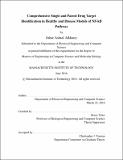| dc.contributor.advisor | Bruce Tidor. | en_US |
| dc.contributor.author | Alkhairy, Sahar Ashraf | en_US |
| dc.contributor.other | Massachusetts Institute of Technology. Department of Electrical Engineering and Computer Science. | en_US |
| dc.date.accessioned | 2016-12-22T15:15:35Z | |
| dc.date.available | 2016-12-22T15:15:35Z | |
| dc.date.copyright | 2016 | en_US |
| dc.date.issued | 2016 | en_US |
| dc.identifier.uri | http://hdl.handle.net/1721.1/105937 | |
| dc.description | Thesis: M. Eng. in Computer Science and Molecular Biology, Massachusetts Institute of Technology, Department of Electrical Engineering and Computer Science, 2016. | en_US |
| dc.description | This electronic version was submitted by the student author. The certified thesis is available in the Institute Archives and Special Collections. | en_US |
| dc.description | Cataloged from student-submitted PDF version of thesis. | en_US |
| dc.description | Includes bibliographical references (pages 81-82). | en_US |
| dc.description.abstract | Nuclear NF-[kappa]B ("NF-[kappa]Bn") is a transcription factor responsible for regulating many genes that play important roles in inter- and intra-cellular signaling, cellular stress responses, cell growth, survival and apoptosis. Defective levels of NF-[kappa]Bn has been associated with cancer, inflammatory, and autoimmune diseases. Therefore, it is important to identify species in the NF-[kappa]B pathway that if inhibited/ targeted by added drugs normalize the levels of NF-[kappa]Bn. Also, since there is a limit to how effective single drug targets are in complicated diseases, identification of combinations of targets is very important. Existing experimental and computational work are disease specific, not comprehensive as they only analyze specific drug targets, and rarely analyze combinations of targets. In this thesis, we computationally modify a healthy model of the pathway to reflect what is defective in different classes of diseases. Then for each of the healthy and disease models, we score individual targets based on how much change in concentration of NF-[kappa]Bn they induce when inhibited with an added inhibitor. Furthermore, we explain (1) why certain species score better than others, (2) why the inhibition profile of the output (NF-[kappa]Bn) is not linear, and (3) why some isoforms of the same species score better than others. We also classify pairs of targets based on whether they are synergistic, additive, or antagonistic and obtain general trends for synergism of target combinations. Finally, we provide a comparison of the identified best targets with previously identified ones. One of our main findings is that very few species are effective at low levels of inhibition but many are effective at extremely high levels of inhibition. We also find that the scores of the species greatly depend on their steady state concentrations, the relative reaction parameters such as nuclear import/export rates and synthesis rates, and the relative concentrations of IKK and NF-[kappa]B. Furthermore, we find that all species that have some effect on the output are synergistic with one another. In departure from other approaches we have computationally targeted both individual proteins and protein complexes, rather than just individual proteins. Although protein complexes score better they are more difficult to inhibit physically. | en_US |
| dc.description.statementofresponsibility | by Sahar Ashraf Alkhairy. | en_US |
| dc.format.extent | 82 pages | en_US |
| dc.language.iso | eng | en_US |
| dc.publisher | Massachusetts Institute of Technology | en_US |
| dc.rights | M.I.T. theses are protected by copyright. They may be viewed from this source for any purpose, but reproduction or distribution in any format is prohibited without written permission. See provided URL for inquiries about permission. | en_US |
| dc.rights.uri | http://dspace.mit.edu/handle/1721.1/7582 | en_US |
| dc.subject | Electrical Engineering and Computer Science. | en_US |
| dc.title | Comprehensive single and paired drug target identification in healthy and disease models of NF-kB pathway | en_US |
| dc.type | Thesis | en_US |
| dc.description.degree | M. Eng. in Computer Science and Molecular Biology | en_US |
| dc.contributor.department | Massachusetts Institute of Technology. Department of Electrical Engineering and Computer Science | |
| dc.identifier.oclc | 965196099 | en_US |
